Description 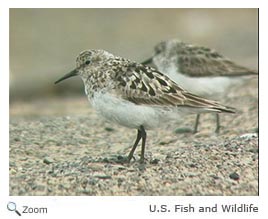 Baird's sandpiper is a
small shorebird
6-7
inches in length with a
14-15
inch wingspan. It has a medium-sized, straight, thin bill; a short neck; a round head; long black legs; and wings that extend beyond its tail. It is white on its undersides and lightly marked with grayish-brown on its neck and breast. It has scallop-shaped brown and black markings edged with white on its back and wings and
white wing-stripes
that are visible when it is in flight. Males and females look alike. Baird's sandpiper is a
small shorebird
6-7
inches in length with a
14-15
inch wingspan. It has a medium-sized, straight, thin bill; a short neck; a round head; long black legs; and wings that extend beyond its tail. It is white on its undersides and lightly marked with grayish-brown on its neck and breast. It has scallop-shaped brown and black markings edged with white on its back and wings and
white wing-stripes
that are visible when it is in flight. Males and females look alike.
Range 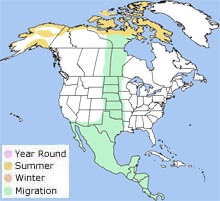 Baird's sandpiper breeds in the arctic regions of Alaska and Canada. It migrates through the Great Plains and winters in
South America.
During migration, it often gathers in flocks in the Great Plains and then flies non-stop, sometimes traveling as far as 4,000 miles, to South America. In the fall, small numbers of Baird's sandpipers can be found on the Atlantic Coast, including in New Hampshire. Baird's sandpiper is also found in the arctic regions of Greenland and Siberia. Baird's sandpiper breeds in the arctic regions of Alaska and Canada. It migrates through the Great Plains and winters in
South America.
During migration, it often gathers in flocks in the Great Plains and then flies non-stop, sometimes traveling as far as 4,000 miles, to South America. In the fall, small numbers of Baird's sandpipers can be found on the Atlantic Coast, including in New Hampshire. Baird's sandpiper is also found in the arctic regions of Greenland and Siberia.
Habitat
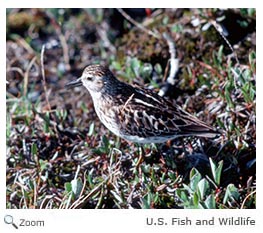 Baird's sandpiper
breeds on the tundra. During migration and in the winter, it is found on mudflats, sandy beaches, estuaries, marshes, and lake and river shores. Baird's sandpiper
breeds on the tundra. During migration and in the winter, it is found on mudflats, sandy beaches, estuaries, marshes, and lake and river shores.
. | |
Diet
Baird's sandpiper eats larvae, beetles, grasshoppers, and spiders. It feeds mostly on land, but it sometimes feeds in shallow water.
Life Cycle
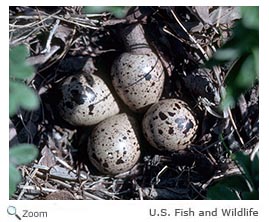 The male builds a shallow scrape lined with lichen, grass, and leaves
among the rocks or in a clump of vegetation. The female Baird's sandpiper lays 4
spotted brown eggs. The male builds a shallow scrape lined with lichen, grass, and leaves
among the rocks or in a clump of vegetation. The female Baird's sandpiper lays 4
spotted brown eggs.
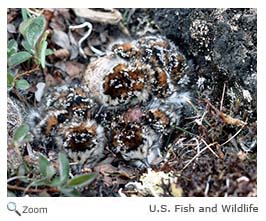 Both parents incubate the eggs for 21-22 days. The chicks are precocial and leave the nest and feed themselves shortly after hatching.
The male and female both care for the chicks, but the female usually leaves them to begin her migration. The male stays with them until they fledge at 16-21 days old. Both parents incubate the eggs for 21-22 days. The chicks are precocial and leave the nest and feed themselves shortly after hatching.
The male and female both care for the chicks, but the female usually leaves them to begin her migration. The male stays with them until they fledge at 16-21 days old.
Fun Fact 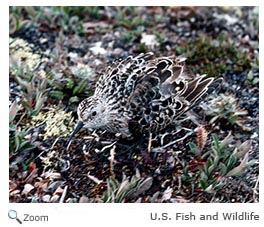 Baird's sandpiper's is named for Spencer Fullerton Baird who was a professor of natural sciences and the Secretary of the Smithsonian Institution. He also headed the Bureau of Fisheries which later became the National Marine Fisheries Service. Baird's sandpiper's is named for Spencer Fullerton Baird who was a professor of natural sciences and the Secretary of the Smithsonian Institution. He also headed the Bureau of Fisheries which later became the National Marine Fisheries Service.
|


 Baird's sandpiper breeds in the arctic regions of Alaska and Canada. It migrates through the Great Plains and winters in
South America.
During migration, it often gathers in flocks in the Great Plains and then flies non-stop, sometimes traveling as far as 4,000 miles, to South America. In the fall, small numbers of Baird's sandpipers can be found on the Atlantic Coast, including in New Hampshire. Baird's sandpiper is also found in the arctic regions of Greenland and Siberia.
Baird's sandpiper breeds in the arctic regions of Alaska and Canada. It migrates through the Great Plains and winters in
South America.
During migration, it often gathers in flocks in the Great Plains and then flies non-stop, sometimes traveling as far as 4,000 miles, to South America. In the fall, small numbers of Baird's sandpipers can be found on the Atlantic Coast, including in New Hampshire. Baird's sandpiper is also found in the arctic regions of Greenland and Siberia.



